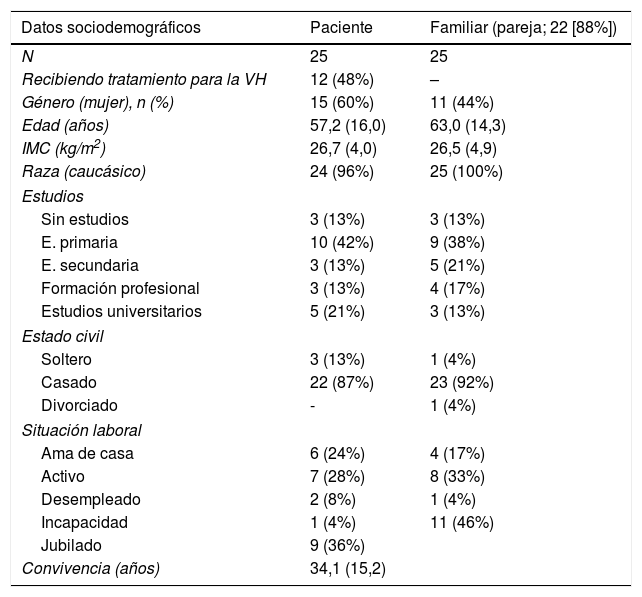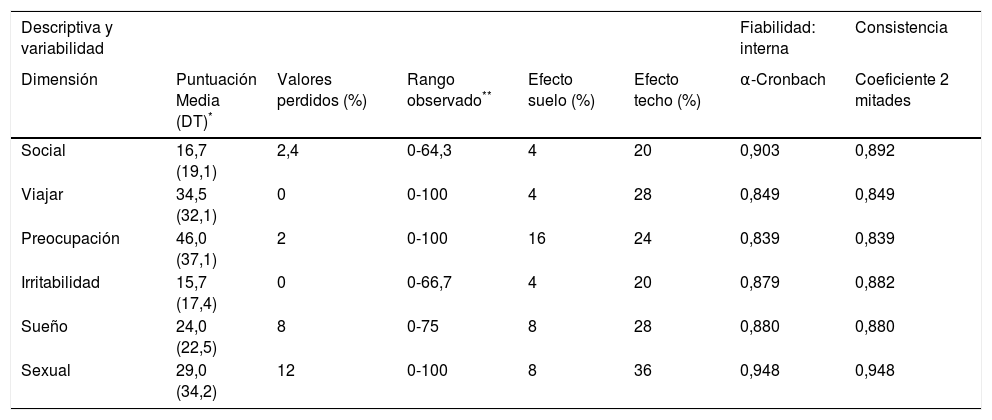El OAB-FIM se desarrolló como una medida del impacto de la vejiga hiperactiva en los familiares que conviven con el paciente. El objetivo fue realizar la adaptación cultural al español (España) del cuestionario OAB-FIM.
MétodosLa adaptación incluyó una fase de validación conceptual y lingüística, y otra de medición de las propiedades psicométricas en 25 familiares (edad media 63,0 años[DE: 14,3], siendo el 44% mujeres) con convivencia habitual con pacientes con vejiga hiperactiva, de ambos géneros y ≥18 años. Se midieron equivalencia conceptual y lingüística, fiabilidad interna, validez de constructo y validez de contenido. Se valoró la aplicabilidad y carga de administración.
ResultadosEl OAB-FIM fue equivalente conceptual y lingüísticamente al original, manteniendo sus 6 dominios: social, viajes, preocupación, irritabilidad, sueño y sexual. El acuerdo interjueces ubicó correctamente a todos los ítems en su dominio, excepto el 10, que se ubicó más en preocupación que en irritabilidad, motivando su reformulación. Un 2,95% de ítems estuvieron ausentes. Los efectos suelo y techo de los ítems variaron, respectivamente, entre 20-28% y 0-16%. El tiempo medio para cumplimentar el cuestionario fue de 5,2 minutos (DE: 2,8) y un 24% necesitó algún tipo de ayuda. El coeficiente α-Cronbach varió entre 0,948-0,839. Las correlaciones con escalas similares en el familiar fueron moderadas-altas (0,407-0,753) o pequeñas-moderadas con las administradas al paciente (0,004-0,423).
ConclusiónSe ha obtenido una versión española (España) del OAB-FIM conceptual y lingüísticamente equivalente al original. El cuestionario ha mostrado buena consistencia interna y validez de contenido y constructo, además de ser aplicable.
The OAB-FIM was developed as a measure of the impact of an overactive bladder (OAB) on relatives who live with the patient. The objective of this study was conduct a cultural adaptation to Spanish (Spain) of the OAB-FIM questionnaire.
MethodsThe adaptation included a conceptual and linguistic validation phase, as well as a phase for measuring the psychometric properties in 25 relatives [mean age, 63.0 years (SD, 14.3); 44% women] who regularly live with patients with OAB, who are of either sex and 18 years of age or older. We measured conceptual and linguistic equivalence, internal reliability, construct validity and content validity. We assessed the applicability and administration load.
ResultsThe OAB-FIM was conceptually and linguistically equivalent to the original, maintaining its 6 domains: social, travel, worry, irritability, sleep and sex. The interagreement correctly placed all items in their domain, except for number 10, which was placed more in worry than in irritability, motivates its reformulation. Some 2.95% of the items were missing. The floor and ceiling effects of the items varied, respectively, between 20-28%, and 0-16%. The mean time for completing the questionnaire was 5.2minutes (SD, 2.8), and 24% of the participants required some type of assistance. The α-Cronbach coefficient varied between 0.948-0.839. The correlations with similar scales in the family were moderate-high (0.407-0.753) or small-moderate with those administered to the patient (0.004-0.423).
ConclusionWe obtained a Spanish (Spain) version of the OAB-FIM that was conceptually and linguistically equivalent to the original. The questionnaire showed good internal consistency, content and construct validity and applicability.
Artículo
Comprando el artículo el PDF del mismo podrá ser descargado
Precio 19,34 €
Comprar ahora
















